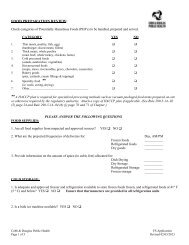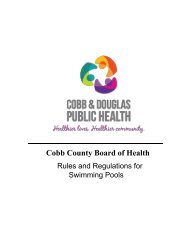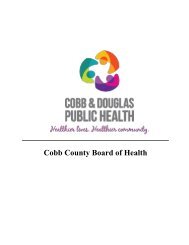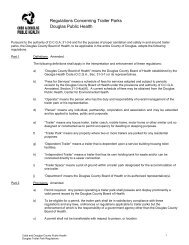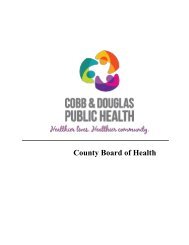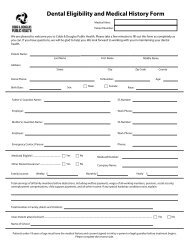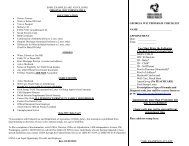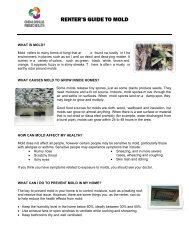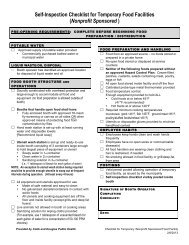RULES OF - Cobb & Douglas Public Health
RULES OF - Cobb & Douglas Public Health
RULES OF - Cobb & Douglas Public Health
You also want an ePaper? Increase the reach of your titles
YUMPU automatically turns print PDFs into web optimized ePapers that Google loves.
Chapter 290-5-14<br />
Food Service<br />
290-5-14-.04 Food. (6) Limiting the Growth of Pathogens (cont.)<br />
(d) Cooling.<br />
1. Cooked potentially hazardous food (time/temperature control for safety food) shall be cooled:<br />
(i) Within 2 hours from 135°F (57°C) to 70°F (21°C); and<br />
(ii) Within a total of 6 hours from 135°F (57°C) to 41°F (5°C).<br />
2. Potentially hazardous food (time/temperature control for safety food) shall be cooled<br />
within 4 hours to 41°F (5°C) or less if prepared from ingredients at ambient temperature, such as<br />
reconstituted foods and canned tuna.<br />
3. Except as specified under 4 of this subsection, a potentially hazardous food (time/temperature<br />
control for safety food) received in compliance with laws allowing a temperature above 41°F (5°C)<br />
during shipment from the supplier shall be cooled within 4 hours to 41°F (5°C).<br />
4. Raw eggs shall be received and immediately placed in refrigerated equipment that maintains an<br />
ambient air temperature of 41°F (5°C) or less.<br />
(e) Cooling Methods.<br />
1. Cooling shall be accomplished by using one or more of the following methods based on the<br />
type of food being cooled:<br />
(i) Placing the food in shallow pans;<br />
(ii) Separating the food into smaller or thinner portions;<br />
(iii) Using rapid cooling equipment;<br />
(iv) Stirring the food in a container placed in an ice water bath;<br />
(v) Using containers that facilitate heat transfer;<br />
(vi) Adding ice as an ingredient; or<br />
(vii) Other effective methods.<br />
2. When placed in cooling or cold holding equipment, food containers in which food is being<br />
cooled shall be:<br />
(i) Arranged in the equipment to provide maximum heat transfer through the container walls;<br />
and<br />
(ii) Loosely covered, or uncovered if protected from overhead contamination during the<br />
cooling period to facilitate heat transfer from the surface of the food.<br />
<strong>Cobb</strong> and <strong>Douglas</strong> County <strong>Public</strong> <strong>Health</strong><br />
<strong>Douglas</strong> Food Service Code<br />
66




